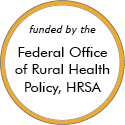Rural Project Examples: Emergency medical technicians and paramedics
Effective Examples
Livingston County Help For Seniors

Updated/reviewed May 2020
- Need: Meeting the health needs of geriatric patients in rural Livingston County, New York.
- Intervention: The Help for Seniors program was developed and using its 'vodcasts,' local EMTs were trained in geriatric screening methods and health needs treatment.
- Results: In addition to developing a successful model for educating EMS personnel, the program screened over 1200 individuals and identified various risks among the geriatric population.
Other Project Examples
Mobile Integrated Healthcare Network (MIHN)

Updated/reviewed November 2025
- Need: To bring preventive care and other services to rural Missouri patients with chronic illnesses and difficulties accessing primary care.
- Intervention: Community paramedics make home visits and provide basic care, home assessments, and medication reconciliation and facilitate telehealth visits.
- Results: Patients experienced improved access to care, health status, and compliance with medication regimens along with increased patient engagement, satisfaction, and access to community resources.
Rural Firefighters Delivering Agricultural Safety and Health (RF-DASH)
Updated/reviewed October 2025
- Need: To reduce injuries in agricultural communities and improve emergency responders' preparedness when called to farms and ranches.
- Intervention: RF-DASH equips rural fire/EMS personnel and others with agricultural health and safety knowledge and tools to pre-plan for agricultural emergencies as well as assess and then mitigate agricultural hazards.
- Results: Over 250 firefighters and EMTs have received training to become RF-DASH trainers.
Queen Anne's County Mobile Integrated Community Health (MICH) Program
Updated/reviewed May 2025
- Need: To connect patients to resources in order to reduce use of emergency services, emergency department visits, and hospital readmissions.
- Intervention: Patients receive support (by in-person visit, phone call, or telehealth visit) from a paramedic, community health nurse, peer recovery specialist, and pharmacist.
- Results: Between July 2016 and March 2024, the program made 1,098 patient contacts and continued to see a reduction in emergency department and inpatient visits and costs.
Simulation in Motion-South Dakota (SIM-SD) EMS Educational Outreach Program
Updated/reviewed April 2025
- Need: To provide increased educational opportunities for emergency care personnel in rural and frontier South Dakota.
- Intervention: A technologically advanced training was created to enhance the delivery of emergency patient care.
- Results: Hundreds of emergency medical services (EMS) staff and volunteers received training that in turn helped them in the field of emergency patient care.
Rural Nevada EMS Conference
Updated/reviewed January 2025
- Need: To provide rural Nevada EMS personnel an opportunity to receive quality training and current EMS information from national EMS educators.
- Intervention: The Rural Nevada EMS Conference offers continuing education units and engaging sessions for EMS personnel.
- Results: In 2024, 185 individuals attended the conference in-person.
COSSA Advanced EMT Class
Added July 2024
- Need: To increase the number of Advanced Emergency Medical Technicians (Advanced EMTs) in rural Idaho and neighboring states.
- Intervention: An Advanced EMT class offered to students at five rural high schools, the first of its kind in the country.
- Results: Two students graduated from the class in its first year, with at least two more expected to enroll in the 2024-25 school year.
AGRIMEDIC
Updated/reviewed February 2024
- Need: To reduce farm injuries and improve EMS and fire/rescue's response to these injuries in rural Louisiana and Mississippi.
- Intervention: AGRIMEDIC is a two-day training for first responders.
- Results: 810 first responders have received training.
Project Swaddle
Added August 2023
- Need: To reduce poor maternal and infant health outcomes and improve access to prenatal and postpartum care for at-risk pregnant women and recent mothers in Crawfordsville, Indiana.
- Intervention: A home visitation program that uses community paramedics to deliver wrap-around care to women experiencing high-risk pregnancies and/or social and environmental challenges.
- Results: Since 2018, more than 200 women have been served by the program.
Maine Critical Access Integrated Paramedics

Added August 2022
- Need: With the nearest hospital more than an hour away, the local community health center in rural Jackman, Maine struggled to maintain its ability to offer 24/7 care to due to staffing and budgetary challenges.
- Intervention: Critical Access Integrated Paramedics provide urgent care to patients after hours and on weekends.
- Results: The Jackman Community Health Center has been able to offer round-the-clock care to clinic patients, while also increasing the level of EMS service available to the community.
For examples from other sources, see:
